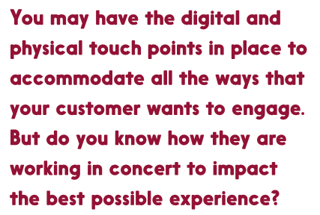- Blog Overview
- Knowledge
- Do you Know How to Connect the Dots in an Omnichannel CX?

Do you Know How to Connect the Dots in an Omnichannel CX?
The Qmatic Team |June 16 2016 | 7 min

Imagine you are out for a special dinner. You start with appetizers and have a few courses, all the way through dessert and coffee. The wait staff is attentive, but not pushy. The environment is welcoming and comfortable. The service is well timed. Your appetizers and dessert are delicious. But the filet mignon you ordered for your main course is overcooked.
The next day at the office, when people ask you about your dining experience, what comes to mind is not one thing in particular. Rather, what you think is that the evening would have been perfect if it hadn’t been for that badly cooked filet mignon. So you review the restaurant as ‘fine; not great.’
It may be that the restaurant is actually great on many nights. It is likely that the people who run the restaurant have given a lot of time and consideration to every detail from service and environment to the menu. Yet, whether by chance or poor oversight, a big part of the total experience didn’t conform to the quality standards of the rest. And the diners who ordered the filets that night noticed the inconsistency.
By now, you know that customer journey, customer service, and the customer experience (CX) are related but not the same. Every piece of the journey might be perfectly constructed and the customer service could be outstanding. But if they don’t work together, the CX will suffer because the customer will notice the lack of consistency – just like they noticed the filet mignon.
With this final installment in our blog series, we reach the most important point – consistency matters. It’s not enough to try to make each piece of the customer journey or each customer service interaction great. They have to be streamlined – that translates to an easy, intuitive, productive experience.
It’s been said that ease is one of the core qualities that produce real luxury and delight. Studies confirm that customers prefer dependability and efficiency even above friendly, personal service.[1] That means customers prefer brands that deliver what they need or want in a way that matches their expectations and enables them to keep moving forward.
As brands engage with customers across more and more channels (mobile, online, on premise, etc.), it’s vitally important to pay attention to every touch point in the customer journey, but also the way that they come together to shape your omnichannel CX. To do that, you have to break down the silos across your business. Taking the time to confirm that each piece is working together and informing the other in a concerted effort will produce the best possible CX for each and every customer, patient, or citizen you serve.
 It’s highly likely that the customer experience will touch all of your engagement points. The experience may not be exactly the same in every channel (online vs. in branch) but both have to feel the same (brand), have the same level of customer service, the same outcome. To clarify, just connecting the digital and physical channels doesn’t create an omnichannel experience. Consistency across the brand, service level, and outcome is how you establish an omnichannel experience.
It’s highly likely that the customer experience will touch all of your engagement points. The experience may not be exactly the same in every channel (online vs. in branch) but both have to feel the same (brand), have the same level of customer service, the same outcome. To clarify, just connecting the digital and physical channels doesn’t create an omnichannel experience. Consistency across the brand, service level, and outcome is how you establish an omnichannel experience.
This is where a fully integrated business intelligence (BI) effort is incredibly valuable. Gathering real-time feedback about the experience from as many customers as possible produces useful insight into each piece of the customer journey and customer service interaction from online shopping or appointment management, through the completion of the task. You can ask specific questions to monitor, track, and measure the CX specifics of each channel.
Vigilance in collecting and using BI is your best opportunity to be truly proactive about fixing weak spots, adjusting service capacity and operational resources, and connecting the dots. For example, you might find that those customers who only interact with your brand in a location have a consistently positive experience, while those who come to you first via an online storefront or calendar application rate their experience much lower. And you’re not going to know how they perceived their experience until it is complete.
Ultimately, the most successful CX is simple and enjoyable for everyone (employees and customers) in every channel at all times. That’s only possible with the commitment, intelligence, and proper resources in place. Smart organizations constantly engage these resources so they can act with agility and innovate ways to improve the whole experience for each customer.
As you’ve seen through this blog series and in the work we do, Qmatic is absolutely dedicated to helping companies and government organizations create the greatest customer experiences possible. We are the global leader in customer journey technology solutions and insights for a reason – it’s because we truly care about the quality of the interactions and outcomes our clients produce for their own customers. If your CX could be even better, get in touch – we can help.
[1] When Good is Even Better than Best…, Forbes BrandVoice, September 2014
Topics
Customer Experience


